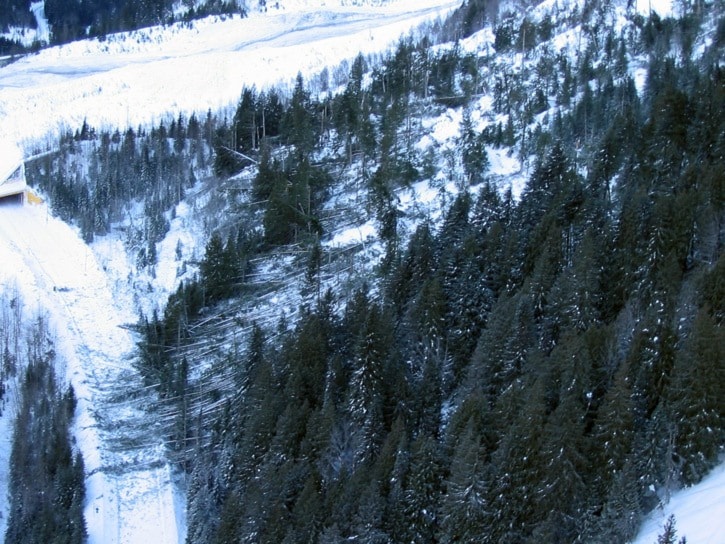Back in November, my editor Aaron and I talked about how we didn’t want to write as much about avalanches this year. Last winter was exceptional – there was the dramatic self-rescue of a group of four snowmobilers on Frisby Ridge, we did a feature on the forecasters at the Canadian Avalanche Centre, provided extensive coverage of the 1910 Rogers Pass avalanche memorial and reported on several tragic avalanche incidents, notably the Boulder Mountain slide that killed two people.
However, events get in the way of plans and the crazy weather the past few weeks led to a surge of avalanche activity, numerous highway closures and even threatened Revelstoke.
The massive avalanche that came down the Lanark slide path 50 kilometres east of Revelstoke last Tuesday at 8:30 a.m. was the talk of town.
It was said to have backed up the Illecillewaet River and officials issued an emergency bulletin just in case. Jerry Silva, the manager of the Revelstoke and Area Emergency Management Program, showed up at council that afternoon.
“It’s not an imminent danger,” Silva told council, saying emergency operations were mobilized “to make sure we are not taken by surprise.”
The slide was rated as a size 4.5 – big enough to destroy a train – and it outran its normal slidepath, tumbled over the Lanark snow shed and into the Illecillewaet River, destroying 100-year-old forest in the process.
According to the ministry of transport, the avalanche broke off at 2,200 metres elevation, slid for 1,500 metres, was 3 metres deep and about 250 metres wide.
The debris from it dammed the Illecillewaet River, pooling the water for some 250 metres upstream, Silva told council.
A story on his report was posted to our website at 3:30 p.m. and the city set up an emergency operations centre at city hall. A few hours later, in an interview the Times Review, Silva played down the threat.
“It [the river] was damming up behind it but it seems to be flowing underneath, through and around,” he said. “That means it’s not going to build up to some kind of huge, tsunami-type thing that’s going to coming thundering down and inundate the city. That really can’t happen.”
I posted an update to our website stating “concerns have diminished” and this time we had some photos of the avalanche showing the amount of trees that were taken out by it. The Glacier National Park avalanche bulletin published the next day stated the slide “destroyed approximately 10 hectares of trees with its air blast alone.”
That night I went out for dinner for a friends going away party and all anyone wanted to ask me about was the avalanche. “Is the town going to flood?” “Was it really that big?” “4.5! That’s crazy!”
The answers: No, yes and, I’m no avalanche expert, but, yes, it is crazy.
The Lanark slide was one of many large avalanches reported around that time and it was the biggest.
“I must stress that several of these avalanches surprised professionals, some of whom are very senior practitioners with many, many years of experience,” wrote Karl Klassen, the lead forecaster with the CAC in a mountain condition report posted to the website of the Association of Canadian Mountain Guides.
On Wednesday, the City of Revelstoke issued a second emergency bulletin indicating the Illecillewaet was continuing to flow “at near-normal rates and a flood surge is unlikely.” On Thursday, water flow was reported to be at normal levels.
The same day, a snowfall warning was issued for the region and more snow came down. The Canadian Avalanche Centre issued a special warning for most of the B.C. Interior and parts of Alberta.
“Different regions have different problems but the fundamental concern applies across the board – there’s up to two metres of new snow sitting on some kind of fragile layer,” explained Klassen.
Given the highway havoc of the previous few weeks, my editor commented that it seemed like the national media was waiting for a tragedy. The CBC even sent a reporter to the Canuck Splitfest, a gathering of split-boarders in Rogers Pass, asking why they’d go out in such risky conditions. The answer – it’s still possible to enjoy the backcountry when the danger is high as long as you play it very safe.
There was one close call – a snowboarder buried by an avalanche while riding out of bounds near Revelstoke Mountain Resort. Fortunately the ski patrol was quick to react and the man was saved.
On Sunday night, the latest avalanche bulletin for the South Columbia Mountains rated the avalanche risk as considerable, down from high, but still risky.
Let’s see if we can get through a week without avalanches making the news.
With files from Aaron Orlando/Times Review
